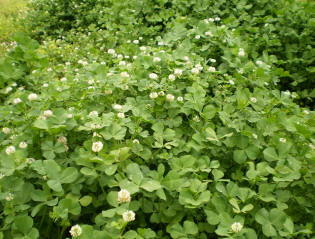White clover is a good source of protein for deer and turkey, and should be considered when developing food plots for deer along with cost of planting and maintenance, duration of plant life and usefulness to wildlife species in the area.
By Mitchell Marks, Alabama Wildlife Biologist, Freedom Hills WMA
When developing wildlife openings, consideration must be given to the crops to be established. White clover, a legume, is a good consideration. Always conduct a soil test prior to planting. This will provide information on the soil pH and fertility.

A pH of 6.0 to 7.0 is desired. Soils with a pH lower than 6.0 will require lime to correct. This is one of the most important steps in establishing a quality clover planting.
If you’re going to grow ’em, you should know how to eat ’em. Check out this fantastic deal on Gut it Cut It Cook It!
Soil tests also will prescribe the type and amount of fertilizer needed. Legumes don’t need the nitrogen component of fertilizer because they fix their own nitrogen. Applying a fertilizer mixture containing nitrogen will be an unnecessary cost and likely benefit weeds and grasses that will compete with the clover. Increased competition will, in turn, increase the cost to control those weeds. The clover seed may come pre-inoculated, but adding additional inoculant will not hurt and in many cases it is advised. The inoculant is necessary for the clover to fix nitrogen.
7 TIPS FOR YOUR BEST FOOD PLOTS EVER
One method to prepare for planting is to spray with glyphosate three to four weeks prior to disking to kill most of the vegetation in the field. Follow that with burning to clear the field and to make the disking easier. If spraying and burning is not an option, then mowing the vegetation will work, but it may require disking two or three times over a two-week period to establish a clean seed bed.
Clover seed should be planted on a firm, moist seedbed. Once the field is prepared, clover seed should be broadcast at a rate of 8 pounds per acre to a depth of 1/8 to 1/4 inches. Using a roller or cultipacker after seeding will aid in firming the soil, helping hold in moisture and get the seed at the appropriate depth. If a roller or cultipacker is not available, lightly drag the field to cover the seed.
Planting the clover with an associate crop, like wheat, at a rate of around 30 pounds per acre, may be beneficial. The wheat will germinate rapidly and hold the soil together, which allows the clover to establish a better root system.
In the spring, grasses and weeds may start coming up in the clover. Spraying with herbicides containing Sethoxydim will kill grasses and a variety of weeds while not hurting the clover. Spraying may be required a couple of times a year to keep competition down. The height of the vegetation should not exceed 12 inches when spraying, so a regular check on fields is needed. Also, mowing several times during the summer will help with controlling competition and create new growth at the top of the clover.
UPGRADE YOUR DEER HABITAT WITH SCREENING COVER
One method of checking the utilization of the clover is to place two or three wire exclosures throughout the field. Exclosures need to be nothing more than wire baskets approximately 3 feet in diameter and 3 to 4 feet tall that protect the vegetation inside from browsing. Exclosures will let you see how the undisturbed clover is doing compared to the clover the wildlife is browsing.
If the browsing on the clover is exceptionally heavy compared to that in the exclosures, this is an indication there is more wildlife than the habitat can support. Consideration should be given to improving foraging areas on the property, reducing the number of animals through appropriate harvest or both.
Mitchell Marks is an Alabama DCNR Wildlife Biologist at Freedom Hills WMA. Check with your state wildlife agency and state agricultural extension service about planting times, methods and other questions related to wildlife habitat and management.











































